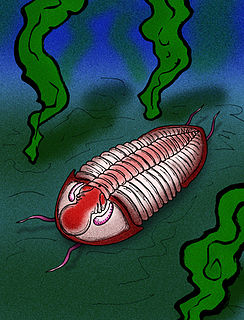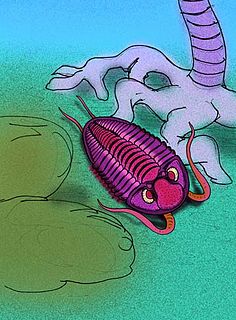The Carboniferous is a geologic period and system of the Paleozoic that spans 60 million years from the end of the Devonian Period 358.9 million years ago (Mya), to the beginning of the Permian Period, 298.9 Mya. The name Carboniferous means "coal-bearing" and derives from the Latin words carbō ("coal") and ferō, and was coined by geologists William Conybeare and William Phillips in 1822.

Trilobites are a group of extinct marine artiopodan arthropods that form the class Trilobita. Trilobites form one of the earliest-known groups of arthropods. The first appearance of trilobites in the fossil record defines the base of the Atdabanian stage of the Early Cambrian period, and they flourished throughout the lower Paleozoic before slipping into a long decline, when, during the Devonian, all trilobite orders except the Proetida died out. The last extant trilobites finally disappeared in the mass extinction at the end of the Permian about 252 million years ago. Trilobites were among the most successful of all early animals, existing in oceans for almost 300 million years.

Proetida is an order of trilobite that lived from the Ordovician to the Permian. It was the last order of trilobite to go extinct, finally dying out in the Permian extinction.

Listracanthus is a genus of extinct chondrichthyan with uncertain affinities. Species of Listracanthus are known primarily from their tremendous, feather-like denticles, which range up to four inches in length. The denticles had a large main spine, from which secondary spines emanate from the sides, like the barbs of a feather or a comb. Listracanthus first appeared in late Carboniferous strata in North America, and eventually disappear from the fossil record some time during the Early Triassic.

Atrypa is a genus of brachiopod with shells round to short egg-shaped, covered with many fine radial ridges, that split further out and growthlines perpendicular to the costae and 2-3 times wider spaced. The pedunculate valve is a little convex, but tends to level out or even become slightly concave toward the anterior margin. The brachial valve is highly convex. There is no interarea in either valve. Atrypa was a cosmopolitan and occurred from the late Lower Silurian (Telychian) to the early Upper Devonian (Frasnian). Other sources expand the range from the Late Ordovician to Carboniferous, approximately from 449 to 336 Ma. A proposed new species, A. harrisi, was found in the trilobite-rich Floresta Formation in Boyacá, Colombia.
Helokybe is a genus of trilobite in the family Proetidae that is known from Silurian age sediments of Nunavut Canada and the Holy Cross Mountains in Poland.

Colosteus is an extinct genus of colosteid tetrapod from the Late Carboniferous of Ohio. Its remains have been found at the Linton site in Saline Township, Ohio, where it is one of the most common tetrapods, and at the Five Points site in Mahoning County, Ohio. It was an elongate, aquatic form with a flattened and pointed head, greatly reduced limbs, two premaxillary tusks, and heavy scalation. It would have reached about 1 m (3.2 ft) in length.

Platyrhinops is an extinct genus amphibamid temnospondyl from the Late Carboniferous of Ohio and the Czech Republic. It is known from many partial skeletons from the Linton site in Saline Township, Ohio and at least 6 partial specimens from the Nýřany site from the Nýřany Member of the Kladno Formation in the Czech Republic.

Proetidae is a family of proetid trilobites. The first species appeared in the Upper Ordovician, and the last genera survived until the Middle Permian. However, if the closely related family Phillipsiidae is actually a subfamily of Proetidae, then the proetids of Proetidae survive until the end of the Permian, where the last perish during the Permian–Triassic extinction event.
Kyrinion is an extinct genus of baphetid tetrapod from the Late Carboniferous of England. It is known from a skull that was found in Tyne and Wear county dating back to the Westphalian stage. Along with the skull is part of the lower jaw, an arch of the atlas bone and a rib possibly belonging to a cervical (neck) vertebra. The type species K. martilli was named from this material in 2003.

Cyclida is an order of fossil arthropods that lived from the Carboniferous to the Cretaceous. Their classification is uncertain, but they are generally treated as a group of maxillopod crustaceans.

Phillipsiidae is a family of proetid trilobites, the various genera of which comprise some of the last of the trilobites, with a range that extended from the Kinderhookian epoch of the Lower Mississippian, to the end of Changhsingian age at Permian-Triassic extinction event in the latest Permian period.
Coelostegus is an extinct genus of Late Carboniferous basal reptile known from Pilsen of Czech Republic. It is known from the holotype ČGH 3027, a partial skeleton of an immature individual. It was collected in the Nýřany site from the Nýřany Member of the Kladno Formation. It was first named by was first named by Robert L. Carroll and Donald Baird in 1972 and the type species is Coelostegus prothales. The most recent phylogenic study of primitive reptile relationships found Coelostegus to be the basalmost known eureptile.
Brouffia is an extinct genus of Late Carboniferous basal reptile known from Pilsen of Czech Republic. It is known from a single partial skeleton, the holotype ČGH III B.21.C.587 and MP 451. It was collected in the Nýřany site from the Nýřany Member of the Kladno Formation. It was first named by was first named by Robert L. Carroll and Donald Baird in 1972 and the type species is Brouffia orientalis.
Anthracodromeus is an extinct genus of Late Carboniferous protorothyridid known from Ohio. It is known from the holotype AMNH 6940, a nearly complete skeleton. It was collected in the Linton site in Jefferson County, from the upper Freeport Coal Member. A. longipes was first assigned by Edward Drinker Cope in 1875 to a species of Sauropleura. The genus was first named by Robert L. Carroll and Donald Baird in 1972 and the type species is Anthracodromeus longipes.

Cummingella is a genus of proetid trilobite in the family Phillipsiidae that lived from the earliest Carboniferous until the last species' extinction in the Middle Permian. Fossils have been found in corresponding marine strata of Western Europe, the United Kingdom and the United States.

Proetus is a genus of proetid trilobite found in Silurian-aged marine strata of Europe.

Triroetus is a genus of proetid trilobite found in Upper Carboniferous-aged marine strata in Russia, and Lower Permian-aged strata of Thailand, Malaysia, Spitzbergen, Yukon Territory, and Middle Permian-aged marine strata of Oman and Texas.

Gerastos is a genus of proetid trilobite in the family Proetidae that lived between the Pragian and Eifelian of the Lower-Middle Devonian, spanning approximately 21 million years.

Acanthorhachis is an enigmatic extinct genus of chondrichthyan from the Carboniferous period. Its name is derived from the Greek word acanthos meaning "spine" and the Greek suffix for spine, -rhachis. This is due to the spine-like dermal denticles and their subsidiary spines, which coated the exterior of the animal. The authors who erected this genus suggested the common name "The Spiny Spined Shark." It is closely related to Listracanthus. It differs from it in the size, structure, and distribution of dermal spines. It is currently monotypic, containing only the species A. spinatus. This shark is thus far only described from the British Isles. Acanthorhachis was first described from the Westphalian-aged lower coal measures of Yorkshire, England. It occurs rarely in Viséan-aged Eyam Limestone of Derbyshire, England.












